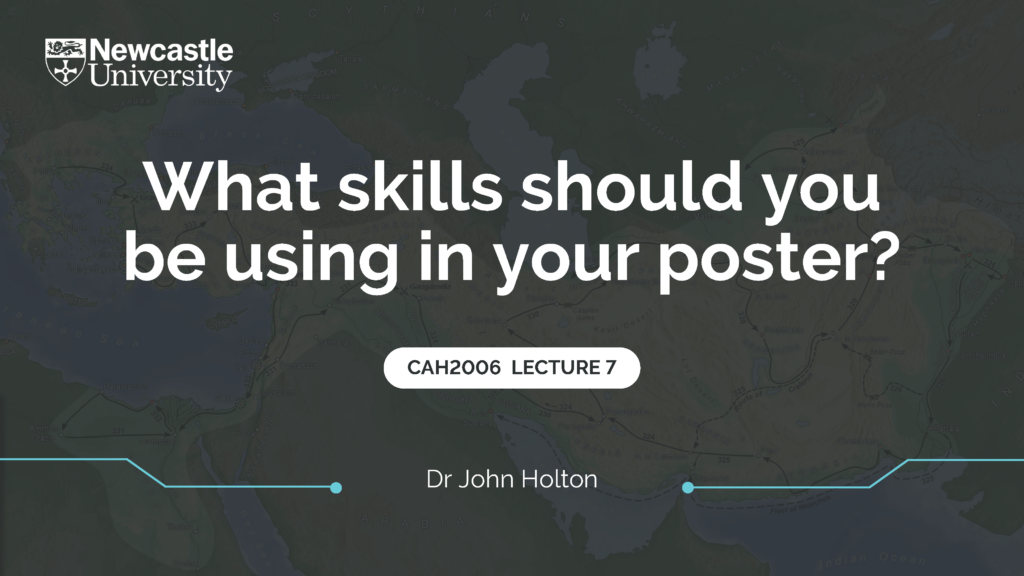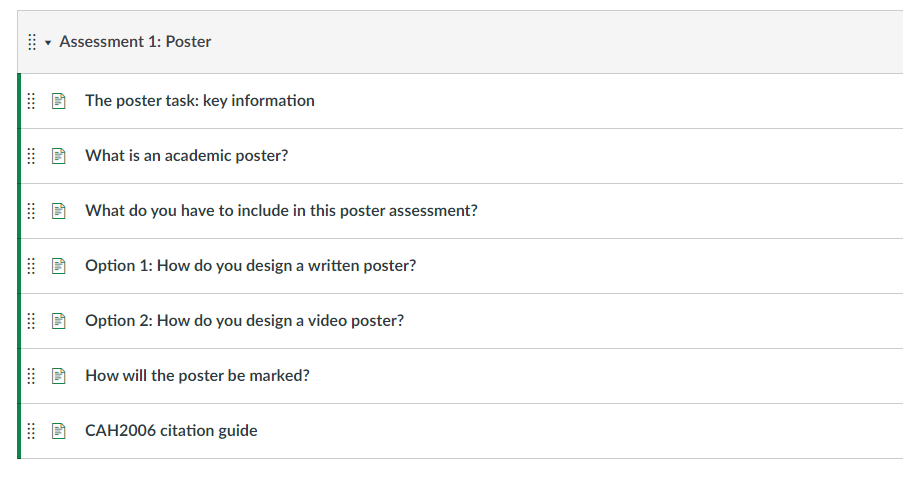Dr John Holton, Senior Lecturer in Ancient History
School of History, Classics and Archaeology
Faculty of Humanities and Social Sciences
What did you do?
I designed a poster assignment as a mid-module assessment for a stage 2 module which has now been tested and iterated over three cycles of delivery. The assessment builds and tests diverse skill-sets through encouraging students to use a professional design platform used widely across workplaces (Canva), it promotes student engagement (often with unfamiliar material) by enabling students to self-select and then personally research their choice of topic within broad parameters, and it encourages self-evaluation of skill-sets by enabling students to choose a mode of design and submission (written or video formats).
Who is involved?
Myself as module leader, plus TA.
How did you do it?
The poster assessment for my stage 2 module has been developed, tested, and refined over 3 years.
In year 1 I introduced a poster that allowed students to research any piece of historical evidence they wished, within the chronological and geographical ambit of the module. Resources and databases were signposted for independent research but students were also able to choose evidence encountered in lectures and seminars (this supported self-discovery but also provided a supportive framework for more cautious students). Key stipulations were that students had to include a specialist modern bibliography, a critical analysis, and a proper citation of the source. Beyond this, free rein was given, although a range of supportive suggestions for framing the discussion were provided. In terms of wider support, a bespoke module on the Canvas course was developed, covering guidance, examples, design help (including guidance on which platforms to use – with Canva as module leader’s suggestion), and more. A whole-class workshop was staged to give guidance and present Q&A opportunities, and small-group seminars were also developed to allow students to share ideas, gain peer-feedback, and discuss the marking criteria.

The CAH2006 Canvas course
In year 2 I introduced optionality to the assessment and formally incorporated this on the MOF: students could write a 750-word written poster, or produce a 5-minute video poster. The instructions and support were maintained and expanded to cover video design, as were the workshop and seminar. A formative assessment was introduced asking student to reflect on assessment readiness and if they knew where support could be found.
In year 3 the optionality was retained and slight tweaks to guidance was made in response to student feedback and queries the previous year. All other aspects were retained. Examples of year 2’s submissions were also showcased in the whole-class workshops to present concrete examples of practice but also build aspirations.
Marks are assigned using standardised criteria. Assessment feedback is triangulated via the use of annotations, summary comments, and a rubric of criteria within Speedgrader.
(I have included reference to the module of assessment support on Canvas Commons in the section below, if colleagues would like to find out more and use any materials.)
Why did you do it?
I wanted to design a mid-module assessment that tested and gave feedback on key academic skills (e.g. source analysis, research into complex historiographies, synthesis of information) ahead of a higher-weighted essay assessment at the end of the module, while also promoting student engagement with learning and self-construction of knowledge. I also wanted to develop an authentic assignment that fosters skills with real-world applications (e.g. communication, digital design, strategic decision-making about workload and direction). This latter motivation is located within the framework of a wider diversification away from exam-based assessments in HCA since COVID. Research among the pedagogical literature, and knowledge that a few other colleagues in the unit used posters (mostly at upper levels – Stage 3 and PGT), made me want to try using a poster for my own sub-discipline with Humanities.
I built careful support into the Canvas course and into the delivery because I knew that an unfamiliar assessment type would need scaffolding and signposting in order to build confidence and enable students to succeed with the independent work and self-regulation required by the assessment. In particular, I included guidance on software and design platforms to compensate for potential digital/technical skills gaps. As part of this, I signposted and advised the use of the design platform Canva in particular, knowing from my own use that it is intuitive and full of helpful templates; but most importantly, I suggested Canva to promote exposure to a design platform widely used across different professions and workplaces, and hence encourage students to develop a digital skill that will be concretely useful after graduation.

John provided support to his students when planning their poster
The introduction of optionality had specific reasons rooted in the module context. In particular, students completing written posters in the first year of running the project were able to demonstrate exceptional levels of creativity and engagement, showing a real investment of time and energy and very tangible skills-development. To provide further outlet and opportunity for these, a video option was provided (hence providing opportunities for video recording and editing in addition to other skills). However, the video was also introduced as an option to support students of different learning backgrounds who may feel more confident in prepared verbal delivery than in written format, and to encourage students to self-evaluate their skill-sets in choosing a mode of submission as part of their development as reflective and self-aware learners (which itself has important impact on employability and ongoing development capacity after graduation).
It should also be stressed that the assessment has been iterated in response to student need and feedback, which has been a key driver of how the framework and support for this assessment has been developed, as well as personal reflection on success and grade profiles of students.
Does it work?

The Assessment of the Poster
From a personal perspective, students have shown an increased assessment confidence after completing an assignment with a format new to them that has been enabled by individual decision-making, deep engagement with the task, uptake of offered support, and self-regulation of work. This confidence and engagement has been borne out in grades too: there have been some exceptional pieces of works achieving well into the high first-class (80-100) boundary. The written poster remains the normative option for most students, but there are a range of video poster submissions that have showcased real achievement for learners of diverse backgrounds.
This high performance is not a product of the unusual format, but rather of an unusually high engagement with the task which has involved self-evaluation, decision-making, and self-construction of knowledge at every step. The video and written posters are also judged carefully by the same criteria and are robustly controlled by a team-marking practice.
The Graduate Framework
This case study demonstrates the following attributes:
- Future focused
- Critical thinkers
- Digitally capable
- Curious
- Engaged
More Information
Canva: A design platform that enables users to create widely different types of content with an unparalleled level of customisation for every design component. In addition to a subscription ‘pro’ plan, it offers a free plan which requires no payments. It includes templates on pretty much any kind of content design – including research posters. You can sign up here, completely free of charge: https://www.canva.com/en_gb/signup/
I have also shared my poster support module on Canvas Commons under the title ‘Poster assessment support – an HCA model.’
